It came so close to perfection.
But for a particularly tragic 90 minutes in which Mohamed Salah picked up an early injury and Loris Karius made some unfortunate, perhaps even concussion influenced, mistakes, Liverpool could have won the Champions League. One game could have made everything sunshine and rainbows, and the world would be talking about Jürgen Klopp’s side as a truly elite side perhaps even on par with Manchester City., Realistically speaking they aren’t that good though, so at least the defeat created some more realistic expectations. That said, Liverpool are really quite good, so the expectation bar for this season remains quite high.
Manchester City’s historic 100 point season had a distorting effect on the rest of the Premier League. They were so far ahead of the pack at just about everything that a distant second was the best anyone could hope for. Liverpool managed to be second in raw shots per game both for and against, second in expected goals conceded, third (behind Tottenham by a hair) in xG created, and second in xG difference. The strong defensive numbers are perhaps the most significant here, with an area of long term struggles slowly getting fixed over the course of the season. When looking at the trendlines, we can see how Liverpool gradually became more solid as the year went on.
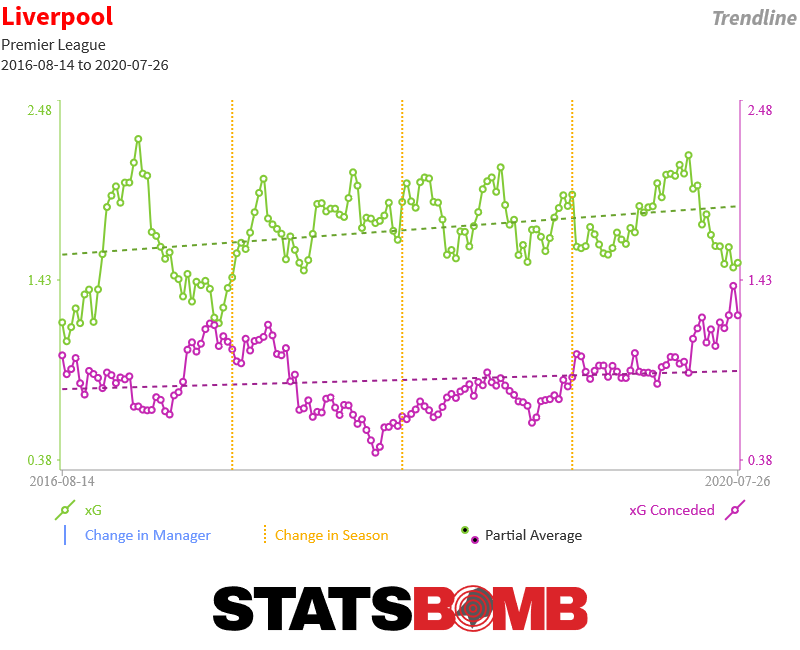
Virgil van Dijk’s signing is easy to look to as a pivotal turning point here, and while he clearly had a positive impact, the improvement started before his arrival. In the first nine games of the season, culminating in the embarrassing 4-1 away defeat to Tottenham, Liverpool conceded 11.35 expected goals, or 1.26 xG per game. In the next 29 games , the side conceded 19.35 xG, a much more pleasing 0.67 per game. It’s possible that this is just random variance, and some bad performances just happened to come earlier in the season, but there’s a decent chance this reflects a genuine improvement.
On the attacking end, the numbers did take a hit, generating 2.01 xG per game for the first 19 games of the season but just 1.56 for the second half. Perhaps that this is just the trade-off for being more solid defensively, and since there was a net gain, it’s worth it. Alternatively, there is the elephant in the room of one Philippe Coutinho. When you sell a star attacking midfielder and buy an expensive centre back, the likeliest scenario is that of course your attack gets worse and your defence improves. The late season injury to Alex Oxlade-Chamberlain and consistent fitness problems of Adam Lallana probably also didn’t help in this sense, as it forced Klopp to play three of Jordan Henderson, James Milner, Emre Can and Gini Wijnaldum, none of whom offer a lot in terms of attacking ball progression.
(It is worth noting here that Liverpool did put in some big attacking performances after the Coutinho sale in the Champions League knockout stages. The small sample size of knockout tournament football makes it difficult to accurately gauge the significance of this, but we can’t rule out the possibility that Liverpool’s best attacking games just happened to occur here and perhaps this season they will occur in the Premier League.)
Obviously Mohamed Salah fueled Liverpool’s attack, managing to hit the joint 38 game Premier League record of 31 goals including just one penalty. There was a touch of the finishing pixie about this, only managing to generate 20.55 expected goals, though we do have some evidence that he may be an above average finisher. Even if he does regress, though, around 20 goals would still be an excellent return for a wide forward who also offers a lot in terms of dribbling and link-up play, so there shouldn’t be an overreaction if his goalscoring comes down a touch (though of course there will be, because it’s the internet).
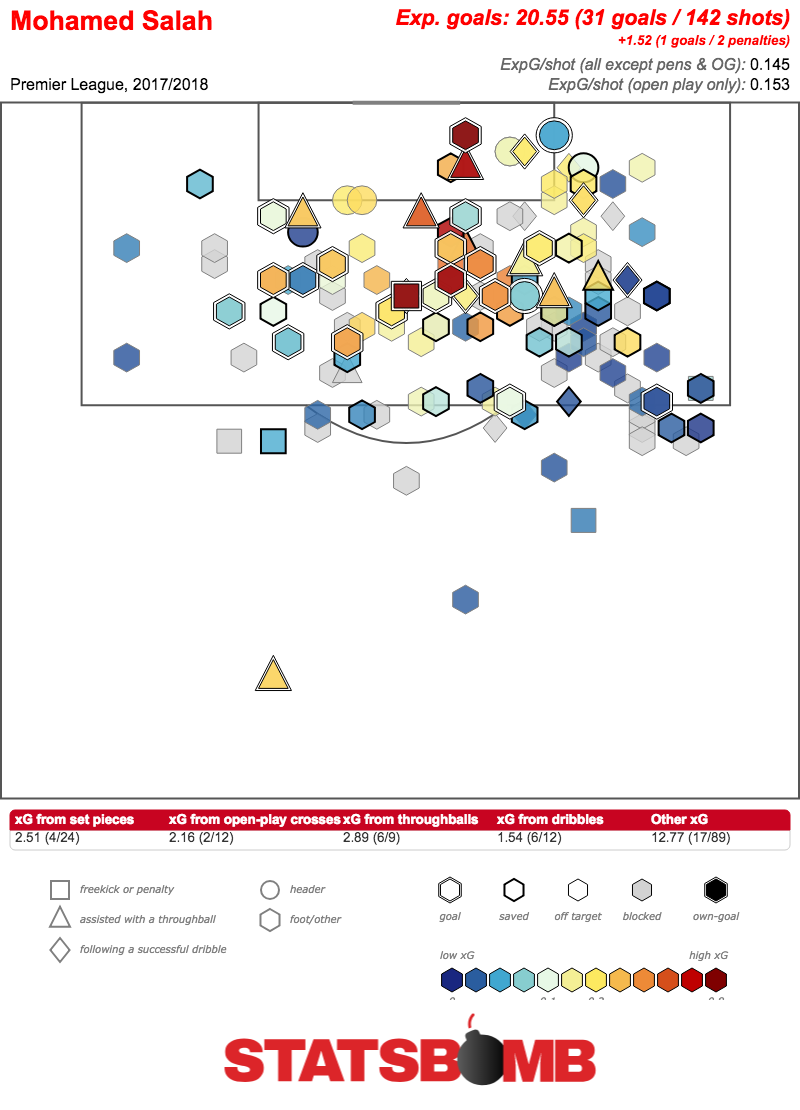
As for how Liverpool go about things, it’s well established that Klopp is an advocate for an aggressive counter press. Liverpool’s high press probably isn’t quite as complete as City’s (who seem to shut down everything in the final third of the pitch to the extent that they really don’t have a lot to do elsewhere), but it’s still impressive to look at.
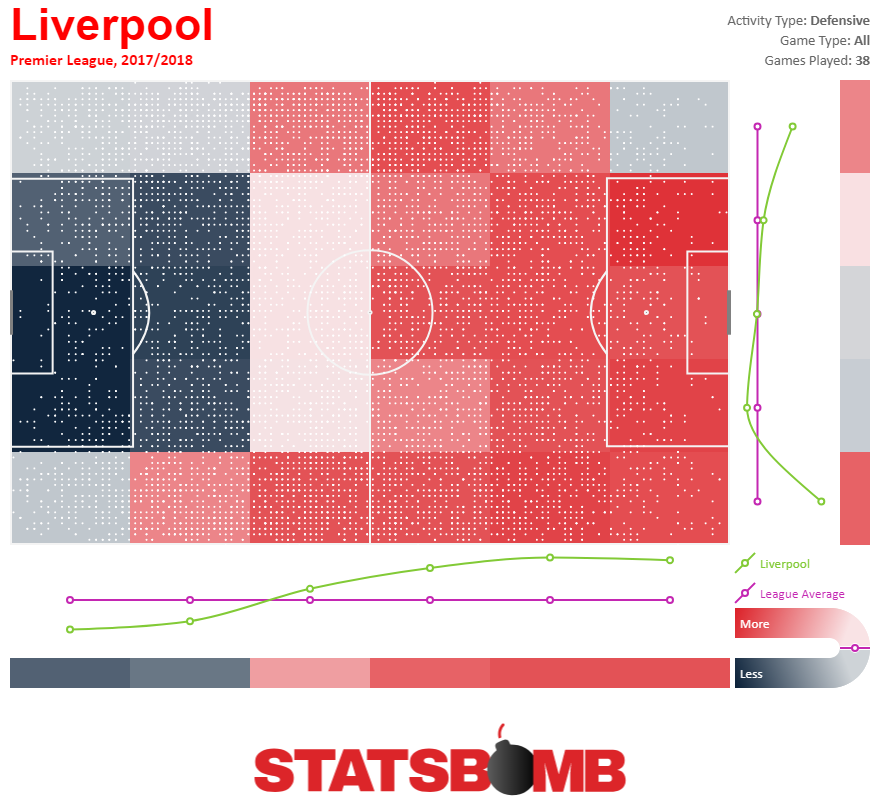
Unsurprisingly Roberto Firmino was the most aggressive presser in the side. His 22.31 pressures per 90 is well ahead of any other striker at a top six Premier League side, and more than double the figures of Harry Kane (9.64) and Romelu Lukaku (10.47). Whether this makes up for his mediocre 9.26 expected goals all season is in the eye of the beholder, but it’s impossible to understate the work he does to trigger Liverpool’s pressing both as a defensive tactic and in order to launch fast attacks in transition.
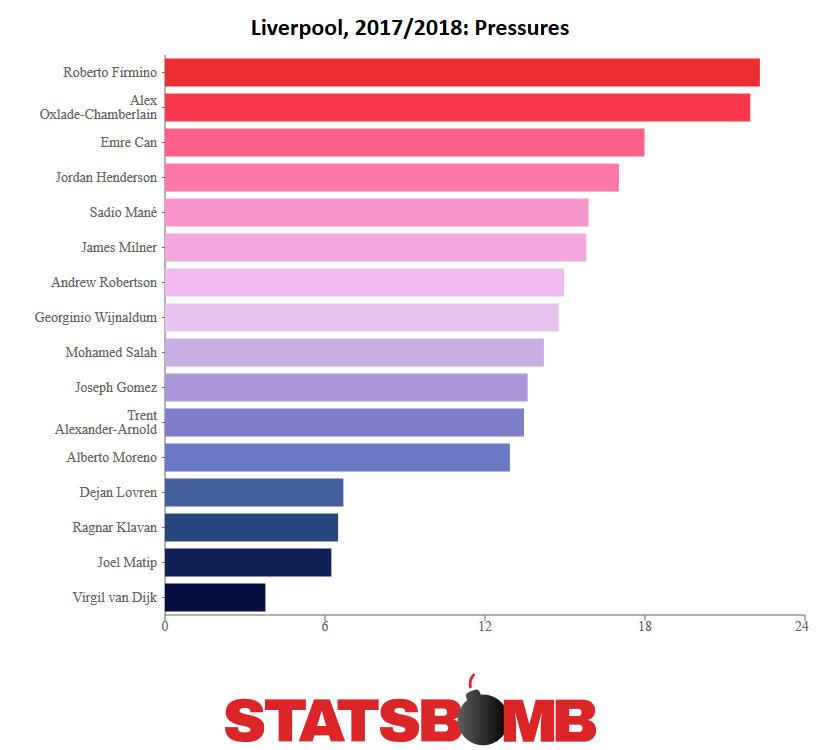
Elsewhere, Andy Robertson finally showed that it is possible to be a specialist left back for Liverpool without constantly embarrassing yourself, while youngsters Trent Alexander-Arnold and Joe Gomez both did solid work on the opposite side. The aforementioned Van Dijk quickly established himself as the side’s key centre back, though neither Dejan Lovren nor Joël Matip provided enough reasons to be the obvious partner to him. Alex Oxlade-Chamberlain’s injury, which rules him out of the entirety of this season, is particularly unfortunate given how important he was in terms of the side’s pressing and ball progression last year. Sadio Mané remains a strong all-round wide forward.
Someone particularly of note from an analytics perspective might be Dominic Solanke. Despite just one goal and one assist last season, the 20 year old striker generated 3.59 expected goals and assisted another 2.6, contributing to the best xGChain per 90 in the Liverpool squad. It must be stressed that 7.3 90s is a very small sample size, but should the Law of Ibrahimovic hold, there’s a good chance this could be a breakout season for Solanke.
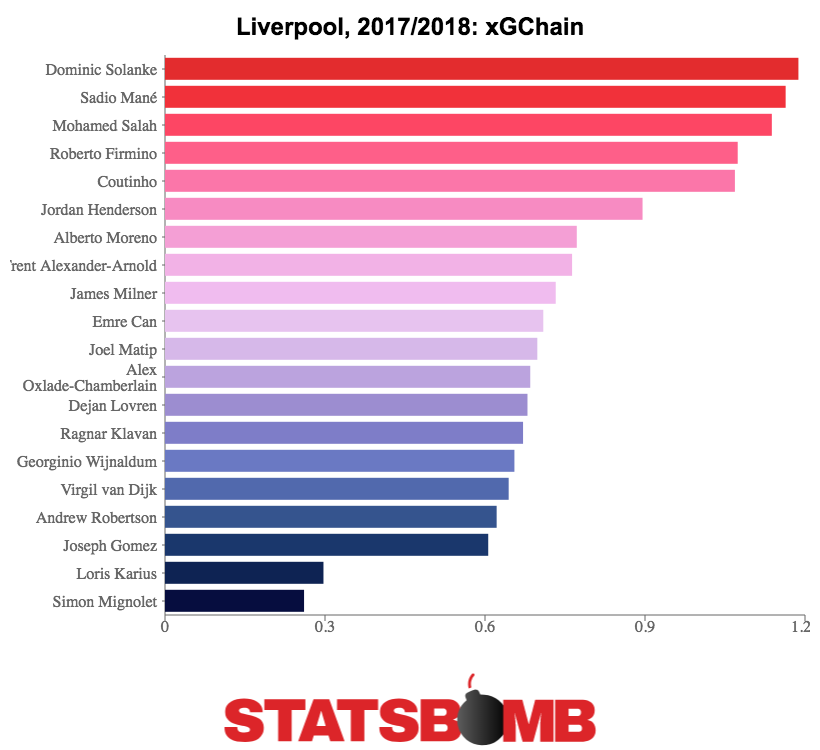
In terms of incomings, Naby Keïta is the standout name, finally arriving from RB Leipzig after the deal was agreed last summer. StatsBomb has been singing Keïta’s praises for a few years now, so we’ll keep it relatively short this time. Keïta’s ability to dribble through a congested midfield is among the best in the world, while he still manages to contribute in terms of goals and assists in the final third as well as working hard defensively. He’s great. With Liverpool’s midfield options generally being more functional than fun (an even greater problem with Oxlade-Chamberlain’s injury), the Guinean should bring a different midfield flavour to the side.
Elsewhere, Fabinho should be solid as an eased in replacement for the injury prone Jordan Henderson as well as an immediate successor to the departed Emre Can., One concern is that Fabinho’s skillset leaves midfield a little light on passing and earlier links to Jorginho and Ruben Neves imply that perhaps Liverpool settled on him after failing to acquire a more nimble ball mover. With the side already having a plethora of hard working, busy midfielders, Fabinho is perhaps too similar to others already in the side. Nevertheless, he should be capable of putting in solid work and playing a lot of minutes without too much trouble.
The crown jewel of Liverpool’s summer business is Roma goalkeeper Alisson Becker. While Karius’s Champions League final performance brought this position under the microscope, the irony is that the goalkeeper position finally looked to be fixing itself before his untimely horrorshow. Since Karius took over goalkeeping duties from Simon Mignolet midway through last season, Liverpool conceded 13 non-penalty goals from 11.24 expected goals, well within the range of normal variance. This is somewhat of a blip, though, and the data available on goalkeeping suggests that Liverpool have conceded more than they should have for a number of seasons now. Alisson has not yet played a huge amount of high level football, but what we have seen from him suggests he will be a significant upgrade. He also rates very well in terms of his distribution, an aspect of the game neither Mignolet (who preferred to be a more conventional shot stopper who would just kick it up the field) or Karius (more comfortable stepping out with the ball at his feet, but never especially good at it) ever impressed in. The pricetag of £66.8 million may well have been an overpay, but it is understandable why the deal was done, and he should prove a decent enhancement.
The £13.75m purchase of Xherdan Shaqiri came as a surprise to many, and as James Yorke has written for StatsBomb, this looks to be a reasonable gamble:
“The first thing to note is that this is quite obviously a percentage play depth signing. The price of around £13.75 million is cheap by comparison to most in today’s market and for that you’re getting a vastly experienced international player who is amazingly still just 26 years old. ...More squad depth will do no harm, and the bottom line is that Liverpool are covering some areas that they are slightly lacking with Shaqiri. There’s quite a lot of player in there for your £13.75 million.”
Shaqiri seems like an obvious attempt to deal with the problem of losing Mohamed Salah half an hour into a Champions League final and having nobody similar to replace him with. Surprisingly, Shaqiri’s one preseason friendly appearance so far has come as the most advanced player in a midfield three, a position he has the raw tools to play, though he may be wanting in terms of work rate and general understanding of the role. It is promising, though, that he seems to have the versatility to do this, especially when the deal for Nabil Fekir, a specialist in that role, fell through.
The failure to get the Fekir deal over the line feels important considering it looks as though nobody else of his profile will be brought in. This is a strategy Liverpool have employed in the past, with the club opting to sign no centre back last summer and wait for Virgil van Dijk rather than bring in a lower priority target. It is possible that Fekir, or someone else not currently available, will be signed in the next twelve months and Liverpool’s patience in the market will pay off. For the time being, however, there are concerns over the lack of a clear attacking midfielder since the sale of Coutinho. The Brazilian's value in terms of creative passing are well known, and his 3.41 open play passes into the box per 90 remain totally unmatched by anyone in the current squad. Klopp’s belief in using the counter press as a playmaker is well known, but it would have been nice to have an actual human playmaker to complement the tactical one. Adam Lallana’s return to fitness does provide more of a passing option in midfield, but he’s not Coutinho, and it is unclear how reliable he’ll be post injury.
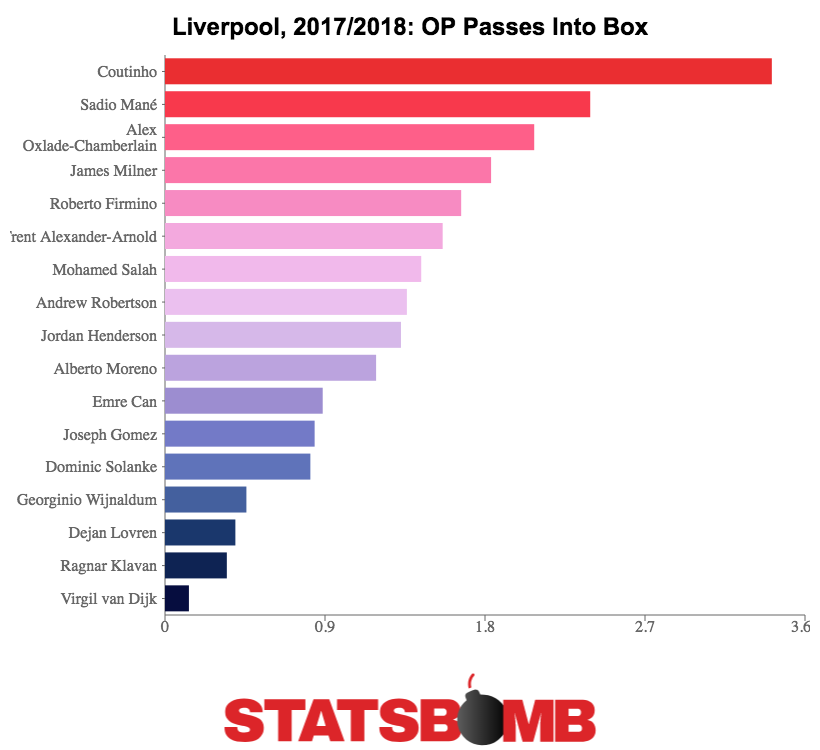
Concerns about creative passing aside, Liverpool are in the best position they’ve been for several years. Long term defensive issues are gradually being eased while the side increasingly has a squad capable of challenging in multiple tournaments. The scale of spending has been significant, attracting a lot of attention in both a positive and negative sense, and that it has been primarily on peak age players tells a story in itself. This is a squad increasingly coming into its prime, and expectations are higher than ever. It is very difficult to make a case that any team other than Manchester City should be favourites to win the league title, but of the chasing pack, Liverpool may be best placed to put pressure on Pep Guardiola’s side and even capitalise if things take an unexpected turn.
Thank you for reading. More information about StatsBomb, and the rest of our season previews can be found here.